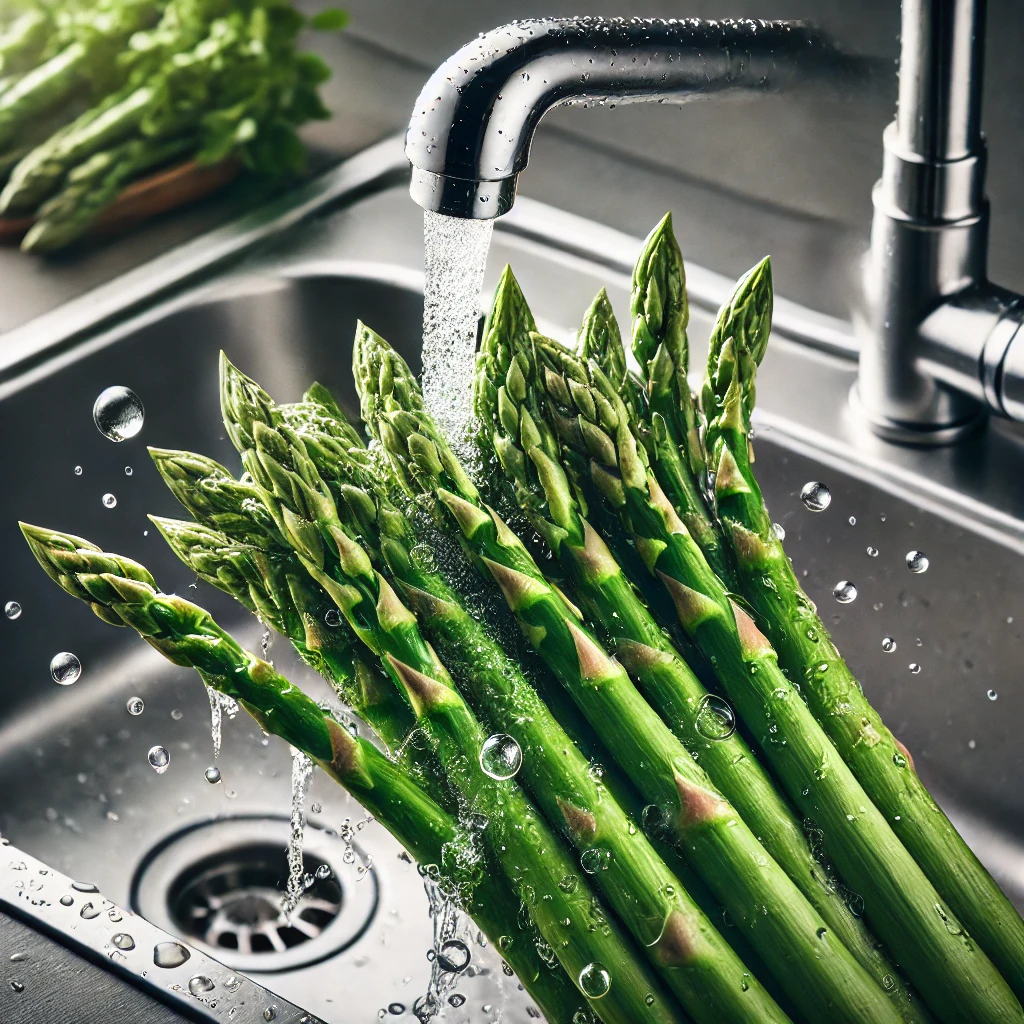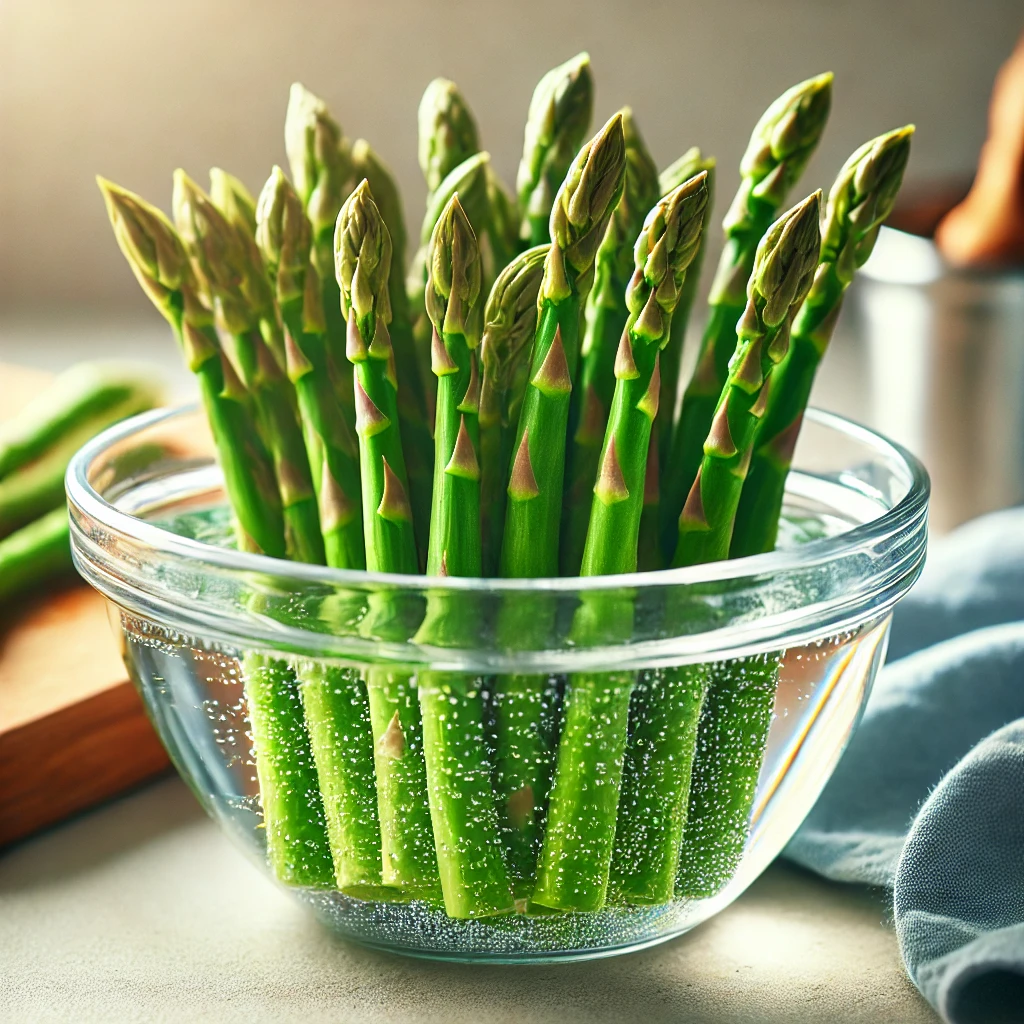Asparagus is a beloved vegetable known for its tender texture, vibrant green color, and versatility in the kitchen. While most people know how to cook asparagus—whether by grilling, steaming, or roasting—there’s an ongoing debate about soaking asparagus before preparation. Why do some people insist on soaking asparagus? Is it a culinary necessity or just an old wives’ tale? In this article, we’ll explore the reasons behind soaking asparagus and whether it’s worth incorporating into your routine.
Table of Contents
ToggleThe Reasons Behind Soaking Asparagus
The idea of soaking asparagus stems from a mix of tradition, practicality, and culinary science. Here are the most common reasons why people soak asparagus before cooking:
1. Removing Dirt and Grit
- The Problem: Asparagus grows in sandy soil, and its tightly packed tips can trap dirt and grit.
- How Soaking Helps: Submerging asparagus in water allows the dirt to loosen and settle at the bottom of the bowl. This ensures that your asparagus is thoroughly clean before cooking.
- Best Practice: Fill a large bowl with cold water and place the asparagus spears in it. Swish them gently and let them sit for a few minutes before rinsing and drying.
2. Softening the Woody Ends
- The Problem: The bottom ends of asparagus spears are often tough and fibrous, making them unpleasant to eat.
- How Soaking Helps: Soaking can slightly hydrate the woody ends, making them easier to trim and less likely to snap unevenly.
- Best Practice: After soaking, bend each spear to naturally snap off the woody section, or trim it with a knife.
3. Reducing Bitterness
- The Problem: Older or thicker asparagus spears can sometimes taste bitter.
- How Soaking Helps: Soaking in cold water, or a solution with a splash of lemon juice or salt, can help neutralize some of the bitterness.
- Best Practice: Soak for 5-10 minutes before proceeding with your recipe.
4. Plumping the Spears
- The Problem: Older asparagus may lose some of its moisture, resulting in a limp texture after cooking.
- How Soaking Helps: Soaking asparagus in water can help rehydrate the spears, restoring their firmness and crispness.
- Best Practice: Soak asparagus in ice water for 10-15 minutes to revive its texture.
5. Preparing for Grilling or Roasting
- The Problem: Asparagus can sometimes dry out on the grill or in the oven.
- How Soaking Helps: While it’s not a required step, soaking asparagus briefly before grilling or roasting can ensure the spears retain more moisture during cooking.
- Best Practice: Pat the spears dry after soaking to avoid steaming them instead of achieving a good char.

When Soaking Asparagus Is Unnecessary
While soaking asparagus has its benefits, there are situations where it’s unnecessary:
1. Fresh Asparagus
- If your asparagus is fresh and clean, soaking may not be needed. Simply rinsing it under running water can suffice.
2. Thin Spears
- Thin asparagus spears are less likely to have tough, woody ends or bitterness, making soaking less critical.
3. Steaming or Boiling
- For methods like steaming or boiling, asparagus is already exposed to water, so a pre-soak might not add any noticeable benefit.
Soaking vs. Washing: What’s the Difference?
It’s important to distinguish between soaking and washing asparagus:
- Washing: Running asparagus under cold water to remove surface dirt or residue.
- Soaking: Submerging asparagus in water for an extended period to achieve additional benefits, such as dirt removal or rehydration.
For everyday cooking, a quick rinse may be sufficient. However, soaking becomes valuable when:
- The spears are visibly dirty or gritty.
- The asparagus is older and needs a texture boost.
- You’re preparing a special dish and want to ensure optimal flavor and texture.
How to Soak Asparagus Properly
If you decide to soak asparagus, follow these steps for the best results:
Step 1: Trim the Ends
- Remove the tough, woody ends of the asparagus before soaking. This allows water to penetrate more effectively.
Step 2: Use Cold Water
- Fill a large bowl or sink with cold water. Ice water is ideal if you’re trying to firm up the spears.
Step 3: Soak and Swirl
- Place the asparagus in the water and gently swish them around to loosen any trapped dirt or debris.
Step 4: Let It Sit
- Allow the asparagus to soak for 5-10 minutes. For older asparagus, extend the time to 15 minutes.
Step 5: Rinse and Dry
- Remove the asparagus from the water, rinse under cold running water, and pat dry with a clean towel. This prevents excess water from interfering with your cooking method.
Is Soaking Asparagus Worth It?
The necessity of soaking asparagus depends on your cooking goals and the condition of your asparagus:
- Yes, soak asparagus if:
- The spears are gritty or dirty.
- The asparagus is older and needs rehydration.
- You’re dealing with bitterness in thicker spears.
- No, skip soaking if:
- The asparagus is fresh, clean, and ready to cook.
- You’re steaming, boiling, or roasting at high heat.
Other Vegetables You Might Need to Soak
Soaking isn’t limited to asparagus. Here are other vegetables that benefit from soaking:
- Corn on the Cob: Soaking helps prevent the husk from burning and adds moisture.
- Mushrooms: Brief soaking removes dirt without damaging their texture.
- Leeks: Soaking loosens dirt trapped in their layers.
- Spinach or Kale: Soaking removes grit from the leaves.
Final Verdict
Soaking asparagus isn’t always necessary, but it can be a helpful step depending on the condition of your vegetable and the cooking method you’re using. For dirt removal, bitterness reduction, and texture enhancement, soaking can make a noticeable difference. However, if your asparagus is fresh and clean, a quick rinse is often enough.
Ultimately, whether you soak or not, the most important thing is to enjoy this delicious vegetable in all its forms—grilled, roasted, steamed, or raw!
FAQs
1. Do you need to soak asparagus before cooking?
- Not always. Soaking is helpful for cleaning or improving texture but isn’t mandatory.
2. How long should you soak asparagus?
- Soak for 5-10 minutes, or up to 15 minutes for older or tougher spears.
3. Does soaking asparagus remove bitterness?
- Yes, soaking in water with lemon juice or salt can reduce bitterness.
4. Can you soak asparagus too long?
- Yes. Prolonged soaking can cause waterlogging and affect texture during cooking.
5. Should I soak asparagus before grilling?
- It’s optional. Soaking can help retain moisture, but drying the spears afterward is crucial.
6. Is soaking asparagus necessary for roasting?
- No, as roasting at high heat naturally locks in moisture.
7. How do I clean asparagus without soaking?
- Rinse under running water, focusing on the tips to remove dirt.
8. Does soaking asparagus make it taste better?
- It can reduce bitterness and improve texture, especially for older spears.
9. Should I soak asparagus for stir-frying?
- A quick rinse is usually sufficient, as stir-frying cooks asparagus quickly.
10. Can I soak asparagus with vinegar?
- Yes, a splash of vinegar can help clean the spears and remove any pesticide residue.

